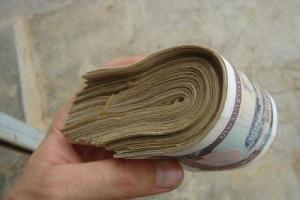It would seem that any invention must be ingenious. But the desire to come up with something unusual sometimes leads to such absurd inventions that it turns out to be 200% surprising, but not everyone wants to use such an innovation.
The most useless inventions
This man must have loved women very much if it occurred to him to invent tights for 3 legs. Indeed, I feel sorry for women who throw away 1/6 of their salary on buying tights because of the slightest tightening or a “running” loop. So three-legged tights appeared, which were patented in the USA in 1997. And they are not for female mutants. They are worn like regular tights, but the “third leg” is hidden on the belt. If the tights are torn on one leg, just replace the “damaged leg” with a third stocking, and everything will be fine.Why isn't the subway cap patented in Japan funny? Put it on your head, pull it over your eyes, and rest while the train is moving. And in order not to oversleep your stop, there is a special slot in it where a sign with the name of the desired station is inserted. A kind neighbor-passenger will always wake you up if the owner of such a cap suddenly falls fast asleep.

Alarm clock for those who are constantly late for work. It looks no different from a regular alarm clock. But a small button the size of a match head is located among the needles densely embedded in the body. Even a normal person has trouble pressing it. But what about those who spent a stormy night the night before, or whose hands are shaking after a merry feast?

Rotating ice cream has been patented in America. The balls inside the cup are constantly moving. All that remains is to stick out your tongue and hope that at least a drop of the delicacy will reach its “destination.”
Among the eccentric inventors there are truly talented people who have left their mark on the world of discovery.
The most famous inventions
A survey was conducted among residents of different countries of the world on the most famous invention of mankind. Oddly enough, the majority of the planet's inhabitants did not attach much importance to those inventions that “shocked” the world. 
The first place was taken by such an invention as letters. They make up words and sentences. This is the language of communication, without which it is impossible to imagine human existence. No inventions or technologies could have been born if letters, signs, and language did not exist.
Anesthesia. It is impossible to imagine how even the simplest operation can be performed without it. The term "anesthesia" belongs to an ancient Roman physician and pharmacologist who lived in the 1st century AD. He managed to isolate narcotic extracts from mandrake root, which had an analgesic effect.

Laughing gas, or nitrous oxide, which relieves pain after several inhalations, was invented by the English chemist Humphry Davy. And the invention of anesthesia using diethyl ether belongs to Dr. Morton. It was from this moment that surgery learned to control pain.

Antibiotics have protected humanity from epidemics and fatal diseases. The inventor of penicillin, the first antibiotic, was Alexander Fleming, who patented this wonder drug in 1928.
How did the invention of the computer change the world?
In the 50s, scientists invented “computers” that resembled huge machines, the main task of which was to correctly calculate the trajectory of space flights. These inventions were called computer technology. Steve Jobs, who patented 230 inventions in the field of information technology, became a computer genius and a legend. Thanks to his genius, not only portable computers appeared, but also iPods and iPhone mobile phones.The computer has become not only a means of collecting and processing information. This is not only a way to transmit any data to almost all parts of the world. This invention is indispensable in process control. With the help of computers, automated control of production processes, automatic robots, and mechanisms for calculating control and measurement data occurs.

They are important in the field of medicine when making diagnoses and examining the body, during complex operations, including transplantation of the heart and other human organs.
Computers are indispensable in the military-technical field. Calculating the flight trajectories of spaceships and satellites, launching them into space, studying the bowels of the earth, predicting natural disasters and observing changes in nature, searching for and extracting minerals, the ability to control the operation of nuclear power plants - this is a tiny part of the opportunities that man received with the invention of the computer.
The most significant invention in human history
It is quite difficult to single out the most significant invention. Scientists have concluded that this is not a rocket, not a light bulb, not television or radio, not the Internet or an iPhone. This is a book. Because the flight of spaceships and airplanes, the mastery of electrical or atomic energy, and much more became possible thanks to the invention of the book. Neither the advent of computer, television or high technology could replace the book. She is the most ancient, reliable carrier and keeper of any information, not requiring any external energy. It still fulfills its main task - to educate and teach people. 
Perhaps the most notable know-how was the invention of the wheel. Some units with wheels are truly impressive; for example, the fastest motorcycles can accelerate to 100 kilometers per hour in 2.5 seconds. .
Subscribe to our channel in Yandex.Zen
In the world of high technology, more and more attention is being paid to robots and their ability to significantly improve human life. In addition to robot assistants, transport plays an important role in our lives. This fall, automotive giants presented concepts that could once and for all solve the issue of urban road congestion and reduce the risk of accidents. We have selected five high-tech new products worthy of your attention.
/ Inventions
Today the market offers a huge selection of tools and cosmetics for professionals in the beauty business. We chose one of the large stores that monitors quality new products, and selected those that seemed most interesting to us.
/ Inventions
We offer all beauty industry professionals the latest review of creative new products from the market leader in the distribution of professional tools for hairdressers, cosmetologists, solariums, as well as furniture and equipment for beauty salons. With Hitek products you will be one step ahead of your competitors.
/ Inventions
Progress does not stand still and every day the world is replenished with countless useful devices that help brighten up our lives and overcome everyday difficulties. This spring, scientists gave us the opportunity to feel like real superheroes, taught us to find a common language with babies and helped the blind to experience the beauty of the world around us.
/ Inventions
Although it seems that scientists around the world are focused solely on creating the latest mobile phones, technology development in other areas is also in full swing. Our top 5 again includes the innovation of Elon Musk, whose name appears every now and then in the news about the achievements of researchers. In addition to his plans to build an advanced metro, we will also tell you about other amazing inventions. And we will start with the most important thing - with a device that can save lives.
/ Inventions
Although February was not marked by such a variety of events in the world of innovation as January, scientists have prepared many interesting innovations for us this month. We will tell you about 5 original inventions: from a space rocket to translator headphones!
/ Inventions
The progressive future has already arrived, corporations are releasing the most powerful computers and smartphones, Elon Musk is once again surprising everyone around him, and new technologies can literally save the lives of millions of people. Read more in our selection of hot technology news for October 2017.
Raytheon engineer Percy Spencer, who was engaged in the manufacture of radar equipment, made one of the most important discoveries for this world in 1945. He discovered that microwave radiation can heat objects. There are several legends about how he figured this out. According to one of them, one day he accidentally left a chocolate bar in his pocket and started working with the magnetron, and a few minutes later he was surprised to feel how the chocolate in his pocket began to melt. Trying to figure out what was wrong, Spencer decided to try other foods: eggs and corn kernels. From what he saw, he concluded that the cause of what was observed was microwave radiation.
Be that as it may, in 1946 Spencer received a patent for the first microwave oven. The first microwave oven, the Radarange, was produced in 1947 by the same company for which he worked. But it was not intended for heating food, but for quickly defrosting food and was used exclusively by the military. Its height was 168 centimeters, its weight was 340 kg, and its power was 3 kW, which is approximately twice the power of modern household microwave ovens. A microwave for the military cost $3,000. In 1965, a household version was released, which sold for $500.
Quinine

For a long time, quinine was used as the main treatment for malaria. Nowadays it can still be found as one of the components of anti-malaria drugs, as well as as an additive to various tonic drinks.
Jesuit missionaries have been using quinine since the early 1600s, discovering it in South America and subsequently bringing it to Europe, however, according to one legend, the use of this substance to treat diseases was practiced by representatives of the Andean civilizations even earlier, and the discovery of quinine, and in particular its properties , is often associated with a case of luck.
This story is not as well documented as the official version of the missionary Bernabe Cobo, who brought quinine from the Indians to Europe and treated the wife of the Viceroy of Peru with it, but we simply could not ignore the interesting legend of luck that later changed this world .
X-ray radiation

In 1895, German physicist Wilhelm Roentgen worked with a cathode ray tube. Despite the fact that the tube itself was shielded, Roentgen noticed that cardboard coated with barium platinum oxide and located next to the tube began to glow in a dark room.
X-Ray tried to block the beams, but most things he placed in front of them had a similar effect. When he finally placed his hand in front of the tube, he noticed that it began to show through the image projected on the screen. He called his discovery “X-rays”. Afterwards, Roentgen replaced the tube with a photographic plate and obtained the first radiograph.
Soon after, the technology was adopted by medical institutions and research laboratories. However, scientists had yet to understand the dangers of long-term exposure to X-rays.
Radioactivity

Radioactivity was discovered in 1896 by the French physicist A. Becquerel. He studied the connection between luminescence and the recently discovered x-rays.
Becquerel decided to find out whether all luminescence is accompanied by X-rays? To test his guess, he took several compounds, including one of the uranium salts, which phosphorescent with yellow-green light. Having illuminated it with sunlight, he wrapped the salt in black paper and placed it in a dark closet on a photographic plate, also wrapped in black paper. After some time, developing the plate, Becquerel actually saw the image of a piece of salt. But luminescent radiation could not pass through black paper, and only X-rays could illuminate the plate under these conditions.
After conducting several similar experiments using uranium salt, he realized that new rays had been discovered that passed through opaque objects, but were not x-rays.
Becquerel established that the intensity of radiation is determined only by the amount of uranium and is completely independent of what compounds it is included in. Thus, this property was inherent not in the compounds, but in the chemical element uranium.
Velcro fasteners

In 1941, Swiss engineer Georges de Mestral decided to take a walk in the Alps with his dog. Upon returning home, he, as usual, began to clean the animal’s hair from the burdock heads. But this time I decided to see how they look under a microscope. As it turned out, each head had tiny hooks, with the help of which they clung to the animal’s fur and clothing.
The engineer did not plan to come up with a new fastener system, but when he saw how easily and firmly the hooks cling to fabric and wool, he still could not resist the temptation. After years of trial and error, he realized that the most suitable material for creating Velcro was nylon.
Velcro fasteners became very popular soon after the technology was adapted by the aerospace agency NASA. Later, Velcro became widely used in the production of casual clothing and shoes.
Saccharin

Saccharin is an artificial sweetener that is approximately 400 times sweeter than sugar. It was discovered in 1878 by Russian-born German chemist Konstantin Fahlberg at Johns Hopkins University. Fahlberg and his supervisor, American professor Ira Remsen, conducted research on bitumen derivatives (coal tars).
After a long day in the laboratory, Fahlberg forgot to wash his hands before dinner. Taking the bread in his hand and biting off a piece, the scientist noticed that it had a sweetish taste, like all other food that he touched with his hands.
He returned to the laboratory and began experimenting with mixing different ingredients, until he eventually discovered that combining ortho-sulfobenzoic acid with phosphorus chloride and ammonia produced a substance with that sweetish aftertaste (it should be noted that the practice of tasting random chemicals not at all typical for scientists).
Fahlberg patented the chemical formula for saccharin in 1884 (without listing Remsen as the patent holder, despite the fact that they had previously published the first scientific paper on this discovery together). Artificial sweetener became widespread during the First World War, when the world's supplies and supplies of sugar were limited.
Tests of the substance showed that it is not absorbed by the body and does not contain calories. In 1907, saccharin as a sugar substitute was adopted by diabetics as a sugar-free diabetic sweetener.
Implantable pacemaker

In 1956, American engineer and inventor Wilson Greatbatch was developing a device that recorded heart rate. Reaching into the box for the resistor that was supposed to complete the circuit circuit, he pulled out the wrong one - the resistor turned out to be larger.
However, after installing this resistor, the engineer discovered that the circuit was emitting electrical ripples. The frequency of the pulsations gave him the idea of a heart rhythm. Greatbatch set out to create a compact, implantable pacemaker. All that remained was to figure out a way to reduce the size of the stimulator so that it could still work.
Two years later, he introduced the first implantable pacemaker, which delivers artificial impulses to stimulate the heart. The device was implanted in a dog. This patented innovation led to the production and further development of pacemakers.
LSD

In 1943, not yet aware of the effect of the resulting drug, Hofmann accidentally absorbed a certain amount of the substance with his fingertips, feeling a pronounced effect of anxiety and dizziness, which he reported to his assistant.
Returning home, he lay down on his bed and “sank into a peculiar state of intoxication, characterized by a very active play of the imagination,” as he himself wrote in his notes. Three days later, Hofmann decided to be the first in the world to intentionally take the drug. This is how he described his feelings after:
“I asked my laboratory assistant, who was informed about the experiment, to accompany me home. We went by bicycle as there was no car due to wartime restrictions. On the way home, my condition began to take on threatening forms. Everything in my field of vision trembled and distorted, as if in a distorting mirror. I also had the feeling that we couldn't move. However, my assistant told me later that we were driving very fast. Finally, we arrived home safe and sound, and I could barely ask my companion to call our family doctor and ask the neighbors for milk. The dizziness and feeling that I was losing consciousness had become so strong by this time that I could no longer stand and had to lie down on the sofa. The world around me has now changed even more horribly. Everything in the room was spinning, and familiar objects and pieces of furniture took on grotesque, menacing shapes. They were all in constant motion, as if possessed by inner restlessness. A woman near the door, whom I barely recognized, brought me milk - I drank two liters throughout the evening. It was no longer Frau R., but rather an evil and treacherous witch in a painted mask.
Even worse than these demonic transformations of the external world was the change in the way I perceived myself, my inner essence. Any effort of my will, any attempt to put an end to the disintegration of the external world and the dissolution of my “I” seemed futile. Some demon possessed me and took over my body, mind and soul. I jumped up and screamed, trying to free myself from him, but then I sank and lay helpless on the sofa. The substance I wanted to experiment with captivated me. It was a demon who contemptuously triumphed over my will.”
Plasticine

The question of who is considered the inventor of plasticine is controversial. In Germany they are considered to be Franz Kolb (patent 1880), in Great Britain - William Harbut (patent 1899). There is another version of the creation of plasticine, according to which this substance was invented by Noah McVicker.
The sticky material was created by Noah McVicker, who at the time worked with his brother Cleo at the soap company Kutol. However, the material McVicker made was not originally intended to be a toy. It was developed as a wallpaper cleaner.
One of the problems that fireplace holders used to heat their homes had to deal with was soot settling on the walls and ruining the wallpaper. The sticky clay promised hassle-free cleaning. However, vinyl wallpaper soon came into fashion, which could be washed with a simple sponge dampened with water, and cleaning clay became obsolete.
When the McVickers were about to go out of business, they came up with a new idea, proposed by a kindergarten teacher named Kay Zufall, who noticed that the material changed shape well and could be used for sculpting. Through mutual close relatives, she communicated this idea to Noah McVicker. He, in turn, decided to remove the detergent component from the material and added dye to it. They decided to replace the original name of the new material “Kutol’s Rainbow Modeling Compound” with the version “plasticine” proposed by Kay.
Penicillin

“When I woke up at dawn on September 28, 1928, I certainly did not plan to revolutionize medicine with my discovery of the world's first antibiotic or killer bacteria. But I guess that’s what I did.”
In 1928, Sir Alexander Fleming, professor of bacteriology, returning to his laboratory after a month of rest with his family, discovered that mold fungi had appeared in one of his Petri dishes, which destroyed the colonies of staphylococci that had previously been in it, but did not touch the others culture.
Fleming attributed the mushrooms that grew on the plate with his cultures to the genus Penicillium and a few months later named the isolated substance penicillin. But since Fleming was not a chemist, he was not able to extract and purify the active substance.
The scientist wrote about his discovery in 1929 in the British Journal of Experimental Pathology, but little attention was paid to his article. Until 1940, Fleming continued his experiments, trying to develop a method for the rapid isolation of penicillin, which could be used in the future for larger-scale applications.
Penicillin was first used to treat humans by British scientists Howard Florey and Ernst Chain on February 2, 1941, ushering in the era of antibiotics.
Viagra

Viagra was the first drug to treat erectile dysfunction, but that was not what it was originally developed for. Its creator is the American company Pfizer, which developed the drug sildenafil, which was intended to treat the heart.
However, during clinical trials it was revealed that the effect of the drug on cardiac blood flow is minimal, but it has a pronounced effect on blood flow in the pelvic organs, accompanied by a longer and stronger erection in men. Even in those cases when people no longer remembered the last time they had it. This is how Viagra appeared.
Additional Pfizer clinical trials involving 4,000 men with erectile dysfunction showed similar efficacy results for the drug.
Insulin

The discovery that later led to the invention of insulin was purely an accident.
In 1889, two doctors from the University of Strasbourg, Oscar Minkowski and Joseph von Mehring, trying to understand how the pancreas affects digestion, removed this organ from a healthy dog. A few days later, they discovered that flies were gathering around the test dog’s urine, which turned out to be a complete surprise.
They analyzed this urine and found sugar in it. Scientists realized that its presence was associated with the removal of the pancreas a few days earlier, which led to the dog developing diabetes.
However, the two scientists never figured out that the hormones produced by the pancreas regulate blood sugar. This was discovered by researchers from the University of Toronto, who, as part of experiments conducted from 1920 to 1922, were able to isolate a hormone that later became known as insulin.
For this revolutionary discovery, scientists from the University of Toronto were awarded the Nobel Prize, and the pharmaceutical company Eli Lilly and Company, one of whose owners knew one of the scientists, began the first industrial production of this substance.
Vulcanized rubber

The inventor of the vulcanization method is considered to be the American Charles Goodyear, who since 1830 has been trying to create a material that can remain elastic and durable in heat and cold.
He treated rubber resin with acid, boiled it in magnesia, added various substances, but all his products turned into a sticky mass on the very first hot day.
The discovery came to the inventor by accident. In 1839, while working at the Massachusetts Rubber Factory, he once dropped a lump of rubber mixed with sulfur onto a hot stove.
Contrary to expectations, it did not melt, but, on the contrary, charred, like skin. In his first patent, he proposed exposing rubber to copper nitrite and aqua regia. Subsequently, the inventor discovered that rubber became immune to temperature effects when sulfur and lead were added.
After numerous tests, Goodyear found the optimal vulcanization regime: he mixed rubber, sulfur and lead powder and heated this mixture to a certain temperature, resulting in rubber that did not change its properties either under the influence of sunlight or cold.
Cornflakes

The history of corn flakes dates back to the 19th century. The owners of the Battle Creek sanatorium in Michigan (USA), Dr. Kellogg and his brother Will Keith Kellogg were preparing some kind of dish from cornmeal, but they urgently needed to leave for urgent boarding business.
When they returned, they discovered that the cornmeal, which was strictly accounted for, had slightly spoiled. But they still decided to make dough from flour, but the dough curdled, resulting in flakes and lumps. Out of desperation, the brothers fried the flakes and found that some of them became fluffy and some had a nice crunchy consistency.
The cereal was subsequently introduced to Dr. Kellogg's patients as a new dish, and served with milk and marshmallows, it was very popular.
By adding sugar to the cereal, Will Keith Kellogg made its taste more palatable to a wider audience.
In 1894, the original corn flakes were patented by American physician John Harvey Kellogg. In 1906, the Kellogs began mass-producing a new type of food and founded their own company.
Teflon

We have chemist Roy Plunkett to thank for the invention of Teflon. In 1938, he worked in one of the DuPont laboratories in New Jersey. At that time, Plunkett was studying the properties of freons.
One day he froze tetrafluoroethylene under strong pressure, resulting in a waxy white powder that later demonstrated amazing properties.
Tormented by curiosity, Plunkett conducted several experiments with the new substance and discovered that the powder was not only heat-resistant, but also had low frictional properties. Two years later, the production of a new material was already launched, and the world recognized it under the name “Teflon”.
Super glue

When American chemist Harry Coover created what would later be called “superglue” in 1942, he was actually experimenting with new materials for sights in military weapons. However, the substance was rejected due to excessive stickiness.
In 1951, American researchers, while searching for a heat-resistant coating for fighter cabins, accidentally discovered the ability of cyanoacrylate to firmly glue various surfaces. In 1955, the development was patented and went on sale in 1959.
For a long time, superglue was present in various American talk shows, where its amazing properties were revealed more and more.
Cyanoacrylate glue could stick to any surface, even if it had not been properly cleaned first. The main problem with this glue is not to firmly glue the parts together, but to separate them later.
Impact resistant glass

Safety glass is widely used in the automotive and construction industries. Today it is everywhere, but when the French scientist Edouard Benedictus accidentally dropped an empty glass flask on the floor in 1903 and it did not break, he was very surprised.
As it turned out, before this, a collodion solution was stored in the flask; the solution evaporated, but the walls of the vessel remained covered with a thin layer of it.
At that time, the automobile industry was rapidly developing in France, and the windshield was made of ordinary glass, which caused many injuries to drivers, which Benedictus drew attention to.
He saw real life-saving benefits in using his invention in cars, but automakers found it too expensive to produce. Now it is used everywhere.
Petrolatum

The name "Vaseline" was patented in the United States as a trademark and trademark in 1878. The well-known cosmetic and medicinal product was invented and patented by the English chemist Robert Chesbrough, who emigrated to America. The oil workers “helped” the scientist with this invention.
When the oil boom began in 1859, Chesbrough, talking with oil workers, became interested in sticky oil - a paraffin-like mass that, during oil production, stuck to drilling rigs and clogged pumps. He noticed that workers constantly use this mass for burns and cuts as a means of successfully healing wounds.
The scientist began experimenting with the mass and managed to isolate useful ingredients from it. He used the resulting substance to smear his numerous burns and scars received during the experiments.
The effect was amazing. The wounds healed quite quickly. Subsequently, Chesbrough continued to improve the amazing wound-healing ability of this substance and, trying it on himself, observed the result.
Modern technologies are rapidly moving forward, making science fiction film footage a thing of the near future. They enter our lives so imperceptibly and organically that there are already a number of inventions that make us wonder. We present to your attention the list - Top 10 the most interesting inventions of mankind of the 21st century. Perhaps some of them will not be in demand at all, but they have the potential to significantly change our lives. Presented here are both inventions for solving specific problems and technologies that can find application in many areas.
1. Mind reading devices
Transferring complex thoughts directly from the brain to various devices is not something we can dream of in the near future. But back in 1998, a gadget went on sale that allowed paralyzed people to turn the light on and off with the power of thought. And in 2008, Japanese scientists led by Junichi Ushiba allowed a paralyzed person to give simple commands to a character in a computer social game. Several large companies today sell telepathic devices that allow you to control applications or toys. They actively cooperate with game manufacturers, which, if events develop well, will give significant results in the future. The use of such devices for medical purposes is also promising. For this reason, a mind reading device could, in the future, become one of the most useful inventions of mankind.
2.

Studies of overweight people who were not helped by dieting showed that most of them secretly ate food, which ruined their efforts. It is impossible to organize such observation for every patient in everyday life. The invention of scientists from Taiwan University is designed to solve this problem, allowing you to monitor the number and frequency of food intake. In the future it is planned to make it more informative and wireless. In addition to nutritionists and psychologists, it may also be useful to doctors of other professions. Of course, if its creators do not abandon work on it and they manage to do everything planned.
3.

Such robots are very useful in performing operations that require special precision and undoubtedly, they can be considered as the most important inventions of mankind made in the 21st century. It may seem that the era of such devices has not yet arrived. But they are already being mass-produced and have become quite widespread. The best known is the daVinci surgical robot, which is a manipulator controlled by a surgeon. Hundreds of thousands of operations are performed on such systems around the world every year. And the American robot “Star” is known for performing intestinal surgery on its own, so it is possible that in the future there will even be competition in this area.
4.

A 3D printer is one of the useful and most unusual inventions of mankind. This device is primarily associated with simple plastic figurines produced at home. But the number of areas in which they are already used or could be useful is enormous. They assist engineers in design, reducing time and costs. You can print useful and small items on them at home. In some industries, especially small-scale ones, producing parts on 3D printers will cost less than on classic lines.
Even in making food, growing organs and creating medicines, this technology could be useful. The US and UK authorities have already had to declare any weapon made on 3D printers illegal. Well, fans of stories about robots taking over the world will be interested to know that there are models that can print more than half of the parts for themselves.
5.

Some people believe that this technology has no future because very few people are using it at the moment. But these devices give large companies a chance to earn huge profits, so their development will not be long in coming. The gaming industry is the most promising for them. In addition, work is underway to organize live broadcasts from sporting events and significant events using virtual reality devices. With their help, movies and TV series will be able to place a person inside the stories being told; they are already being actively used to train American soldiers. And that's not all: healthcare, education, real estate sales - all these are potential areas of application of virtual reality.
6. Sixth Sense
If the previous technology immerses a person in virtual reality, then this device, on the contrary, helps it penetrate our world. This invention can be included in the list that contains the most interesting inventions of mankind. Sixth Sense allows you to use almost any surface as a display and interact with it using your hands with special marks on your fingers. The prototype, made by MIT students, is assembled from publicly available parts and costs only $350. The system allows you to find information on the Internet about objects simply by looking at them, displaying it on any surface. Or dial a phone number by projecting the numbers onto your hand. At the moment it is at the development stage and is far from mass release.
7.

They are widely used by the military, and even a civilian can buy a model in a store that allows them to take photographs and videos from a great height. Their main difference is that the UAV requires constant exchange of information with the control panel. And drones can perform tasks autonomously. They are planned to be used for distributing the Internet, delivering medicines, food and other goods. They are also capable of measuring indicators in places that are dangerous to humans. They are already used for advertising purposes and even as waiters.
8. Holograms
Many people remember scenes from science fiction films where a conversation is conducted with a hologram of a person, creating the full effect of his presence in the room. At the moment there are no such technologies. But it is already possible to reproduce a fairly high-quality image on stage. One of the most famous examples of this is the Tupac hologram. And the Japanese Hatsune Miku is generally a completely artificial star who gave real concerts. The first prototypes have been presented, producing three-dimensional images of not very high quality. You can even interact with them using your hands.
9.

Caring for seriously ill patients is difficult and exhausting work. It is not surprising that inventors from different countries offer their own technical solutions to make it easier. In the future, such robots may prove to be one of the most important inventions of mankind. The Japanese have created a robot capable of transferring a person from a bed to a chair and back, moving over long distances. And students at the University of Massachusetts presented an android capable of delivering various subjects and self-learning as it goes. Today, robots are not able to provide normal human care; they can only perform a few actions. The future will tell whether they will be able to replace caregivers in full.
10. Organ cultivation

Growing organs is unusual, incredibly useful and the most interesting invention of mankind, made in the 21st century and opening up prospects for practically eternal life. The shortage of organs suitable for transplantation leads to the fact that many people simply do not wait their turn or cannot afford such an operation. There is also a thriving black market for illegally obtained body parts. But cells have an amazing ability to self-organize into complex tissues, which already allows scientists to conduct successful experiments to obtain new organs.
Using patient cells minimizes the risk of rejection. Growing skin for extensive burns is already being actively used, and a technique for producing artificial tracheas has been developed. Teeth, cartilage, blood vessels, muscles, blood, kidneys, bladder - this is not a complete list of what scientists were able to obtain under artificial conditions and transplant into animals. Naturally, these technologies have not been proven and science will have to solve a lot of problems for their widespread implementation.
Famous inventors of the world have created many useful things for humanity. Their benefit to society is difficult to overestimate. Many ingenious discoveries have saved more than one life. Who are they - inventors known for their unique developments?
Archimedes
This man was not only a great mathematician. Thanks to him, the whole world learned what a mirror and a siege weapon are. One of the most famous developments is the Archimedes screw (auger), with which you can effectively bail out water. It is noteworthy that this technology is still used today.
Leonardo da Vinci
Inventors, known for their brilliant ideas, did not always have the opportunity to bring their ideas to life. For example, drawings of a parachute, an airplane, a robot, a tank and a bicycle, which appeared as a result of the painstaking work of Leonardo da Vinci, remained unclaimed for a long time. At that time, there were simply no engineers or capabilities to implement such grandiose plans.
Thomas Edison
The inventor of the phonograph, kinescope and telephone microphone was the most famous. In January 1880, he filed a patent for an incandescent lamp, which later made Edison famous throughout the planet. However, some do not consider him a genius, noting that the inventors known for their inventions worked alone. As for Edison, a whole group of people helped him.

Nikola Tesla
The great inventions of this genius were brought to life only after his death. Everything is explained simply: Tesla was so powerful that no one knew about his work. Thanks to the efforts of the scientist, a multiphase electric current system was discovered, which led to the emergence of commercial electricity. In addition, he formed the foundations of robotics, nuclear physics, computer science and ballistics.

Alexander Graham Bell
Many inventors, famous for their discoveries, have helped make our lives even better. The same can be said about Alexander Bell. Thanks to him, people were able to communicate freely, being thousands of kilometers away from each other, and all thanks to the telephone. Bell also invented the audiometer, a special device that detects deafness; treasure hunting device - a prototype of a modern metal detector; the world's first airplane; a model of a submarine, which Alexander himself called a hydrofoil boat.

Karl Benz
This scientist successfully realized the main idea of his life: a vehicle with a motor. It is thanks to him that we have the opportunity to drive cars today. Another valuable invention of Benz was the internal combustion engine. Later, a car manufacturing company was organized, which today is known throughout the world. This is a Mercedes Benz.
Edwin Land
This famous French inventor devoted his life to photography. In 1926, he managed to discover a new type of polarizer, which later became known as the Polaroid. Land founded Polaroid and filed patents for another 535 inventions.
Charles Babbage
This English scientist worked on creating the first computer back in the nineteenth century. It was he who called the unique device a computing machine. Since at that time humanity did not have the necessary knowledge and experience, Babbage’s efforts were not crowned with success. However, the brilliant ideas did not sink into oblivion: Konrad Zuse was able to implement them in the mid-twentieth century.
Benjamin Franklin
This famous politician, writer, diplomat, satirist and statesman was also a scientist. The great inventions of mankind that saw the light of day thanks to Franklin are the flexible urinary catheter and the lightning rod. Interesting fact: Benjamin, as a matter of principle, did not patent any of his discoveries, because he believed that they were all the property of mankind.

Jerome Hal Lemelson
Such great inventions of mankind as the fax machine, the cordless telephone, the automated warehouse and the magnetic tape cassette were introduced to the general public by Jerome Lemelson. In addition, these scientists developed diamond coating technology and some medical devices that help in the treatment of cancer.

Mikhail Lomonosov
This recognized genius of various sciences organized the first university in Russia. Mikhail Vasilyevich's most famous personal invention is an aerodynamic machine. It was intended to lift special meteorological instruments. According to many experts, Lomonosov is the author of the prototype of modern aircraft.
Ivan Kulibin
It is not for nothing that this man is called the brightest representative of the eighteenth century. Ivan Petrovich Kulibin was interested in the principles of mechanics from early childhood. Thanks to his work, we now use navigation instruments, alarm clocks, and water-powered engines. For that time, these inventions were something of a fantasy. The genius's surname even became a household name. Kulibin is now called a person who has the ability to make amazing discoveries.
Sergey Korolev
His areas of interest were manned astronautics, aircraft engineering, design of rocket and space systems and missile weapons. Sergei Pavlovich contributed significantly to the exploration of outer space. He created the Vostok and Voskhod spaceships, the 217 anti-aircraft missile and the 212 long-range missile, as well as a rocket plane equipped with a rocket engine.
Alexander Popov
And this radio receiver is precisely this Russian scientist. The unique discovery was preceded by years of research into the nature and propagation of radio waves.
The brilliant physicist and electrical engineer was born into the family of a priest. Alexander had six more brothers and sisters. Already in childhood, he was jokingly called a professor, since Popov was a shy, thin, awkward guy who couldn’t stand fights and noisy games. At the Perm Theological Seminary, Alexander Stepanovich began to study physics based on Gano’s book. His favorite pastime was assembling simple technical devices. The acquired skills were subsequently very useful to Popov when creating physical instruments for his own important research.
Konstantin Tsiolkovsky
The discoveries of this great Russian inventor made it possible to take aerodynamics and astronautics to a new level. In 1897, Konstantin Eduardovich finished working on the wind tunnel. Thanks to allocated subsidies, he calculated the resistance of a sphere, cylinder and other bodies. The data obtained were subsequently widely used by Nikolai Zhukovsky in his works.
In 1894, Tsiolkovsky designed an airplane with a metal frame, but the opportunity to build such an apparatus appeared only twenty years later.

Controversial issue. The inventor of the light bulb - who is he?
The creation of a device that produces light has been worked on since ancient times. The prototype of modern lamps were clay vessels with wicks made of cotton threads. The ancient Egyptians poured olive oil into such containers and set it on fire. Residents of the Caspian Sea coast used another fuel material - oil - in similar devices. The first candles made in the Middle Ages were made from beeswax. The well-known Leonardo da Vinci worked hard to create, but the world's first safe lighting device was invented in the nineteenth century.
The debate about who should be awarded the honorary title “Inventor of the Light Bulb” is still ongoing. The first is often called Pavel Nikolaevich Yablochkov, who worked as an electrical engineer all his life. He created not only a lamp, but also an electric candle. The latter device has become widespread in street lighting. The miracle candle burned for an hour and a half, after which the janitor had to change it for a new one.
In 1872-1873 Russian engineer-inventor Lodygin created an electric lamp in its modern sense. At first, it emitted light for thirty minutes, and after pumping out the air from the device, this time increased significantly. In addition, Thomas Edison and Joseph Swan claimed primacy in the invention of the incandescent lamp.
Conclusion
Inventors around the world have given us many devices that make life more comfortable and varied. Progress does not stand still, and if a few centuries ago there simply weren’t enough technical capabilities to implement all the ideas, today it is much easier to bring ideas to life.








